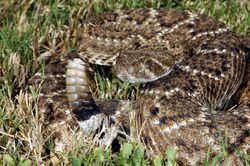Biology:Caenophidia
| Caenophidia | |
|---|---|

| |
| Western diamondback rattlesnake (Crotalus atrox) | |
| Scientific classification | |
| Domain: | Eukaryota |
| Kingdom: | Animalia |
| Phylum: | Chordata |
| Class: | Reptilia |
| Order: | Squamata |
| Suborder: | Serpentes |
| Clade: | Afrophidia |
| Clade: | Caenophidia Hoffstetter, 1939 |
| Subclades | |
| |
| Synonyms | |
|
Xenophidia | |
The Caenophidia are a derived clade of alethinophidian snakes, which contains over 80% of all the extant species of snakes.[1] The largest family is Colubridae, but it also includes at least seven other families,[1] at least four of which were once classified as "Colubridae" before molecular phylogenetics helped us understand their relationships. It has been found to be monophyletic.[1]
Although the Caenophidia previously was held to exclude Acrochordidae, researchers have recognized that acrochordids share several traits with the other caenophidians.[2] Hence Caenophidia is usually considered to comprise Acrochordidae plus more the more derived snakes classified as Colubroidea. Recent molecular studies have also found the families Xenophidiidae and Bolyeriidae to be closely related to caenophidians, forming the sister group to Caenophidia rather than being part of Henophidia.[3][4]
Below is a phylogeny of the Caenophidia based on analyses from several studies:[5][3][4]
| ||||||||||||||||||||||||||||||||||||||||||||||||||||||||||||||||||||||||||||||||||||||||||||||||||||||||||||||||||||||||||||||||||||||||||||||||||||||||||||||||||||||||||||||||||||||||||||||||||||||||||||||||||||||||||||||||||||||||||||||||||||||||||||||||||||||||||||||||||
References
- ↑ 1.0 1.1 1.2 Vidal, Nicolas; Delmas, Anne-Sophie; David, Patrick; Cruaudd, Corinne; Couloux, Arnaud; Hedges, S. Blair (2007). "The phylogeny and classification of caenophidian snakes inferred from seven nuclear protein-coding genes". Comptes Rendus Biologies 330 (2): 182–187. doi:10.1016/j.crvi.2006.10.001. PMID 17303545. https://comptes-rendus.academie-sciences.fr/biologies/articles/10.1016/j.crvi.2006.10.001/.
- ↑ Rieppel, O. (1979). "A cladistics classification of primitive snakes based on skull structure". Journal of Zoological Systematics and Evolutionary Research 17 (2): 140–150. doi:10.1111/j.1439-0469.1979.tb00696.x.
- ↑ 3.0 3.1 Reynolds, RG; Niemiller, ML; Revell, LJ (2014). "Toward a Tree-of-Life for the boas and pythons: multilocus species-level phylogeny with unprecedented taxon sampling". Molecular Phylogenetics and Evolution 71: 201–213. doi:10.1016/j.ympev.2013.11.011. PMID 24315866. http://www.rgrahamreynolds.info/wp-content/uploads/2014/01/Reynolds_etal_2014_MPE.pdf. Retrieved 2019-03-04.
- ↑ 4.0 4.1 Figueroa, A.; McKelvy, A. D.; Grismer, L. L.; Bell, C. D.; Lailvaux, S. P. (2016). "A species-level phylogeny of extant snakes with description of a new colubrid subfamily and genus". PLOS ONE 11 (9): e0161070. doi:10.1371/journal.pone.0161070. PMID 27603205. Bibcode: 2016PLoSO..1161070F.
- ↑ Pyron; Burbrink; Wiens (2013). "A phylogeny and revised classification of Squamata, including 4161 species of lizards and snakes". BMC Evolutionary Biology 13: 93. doi:10.1186/1471-2148-13-93. PMID 23627680.
Wikidata ☰ Q13502819 entry
 |

